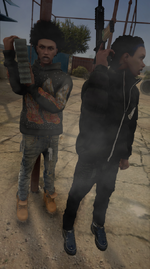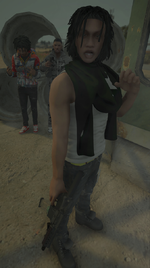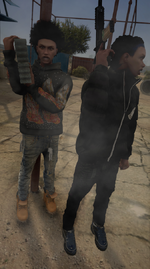
The starting of 1700 TossGang

In recent years, North Avenue in West Chicago has become infamous as a focal point of violent activity, largely due to the activities of the gang known as the "Toss Gang." This organization traces its origins back to the late 1990s, specifically on the streets of Leamington and Leclaire, and is centered in an area referred to as L-Block. This region encompasses four separate factions that extend from 1400 to 1700. The majority of L-Block is composed of members from the 4CH faction, with a handful of individuals affiliated with the Black Disciples (BDs) also present. Over the years, the members of L-Block have asserted their control over key locations, particularly on Lemoyne and Lawler streets, as well as LaFollette Park, which has become a common gathering place for the youth.
A significant evolution within the gang dynamics occurred in the late 2010s, when a new generation proclaimed themselves the legitimate successors to the Toss Gang legacy. This assertion, which they expressed through various interviews and musical endeavors, ignited hostilities with a rival faction known as "TossNem." The members of TossNem contend that their identity as a group emerged in direct response to the establishment of the original Toss Gang in L-Block, further complicating the already tense gang landscape.
Throughout the years, L-Block has adopted a policy of neutrality, carefully navigating its affiliations with other gangs. While they maintain a degree of distance from formal alliances, they have acknowledged loose connections with groups such as the DCG (Black Disciples) and the Jackboys (4CH). Their confrontational approach is not limited to local rivals; they actively engage in online provocations and musical diss tracks targeting adversaries throughout Chicago. In spite of the ongoing violence that plagues their community, L-Block members take pride in a disturbing distinction: they claim to have avoided any fatalities resulting from gun violence. This assertion is frequently highlighted in their social media interactions, musical compositions, and public statements, serving as both a badge of honor and a declaration of resilience in the face of adversity.
The surge in violence across Chicago has reached alarming levels, leading to the city being infamously labeled "Chiraq." This designation stems from the alarming frequency of shootings, which has drawn unsettling comparisons to conflict zones such as Iraq. Although certain media outlets have branded Chicago as the "Murder Capital of America," such assertions can be seen as hyperbolic. While it is undeniable that the city grapples with a troubling number of homicides, when examined on a per capita basis, its figures fall short when compared to other cities, notably New Orleans, which has recorded murder rates ranging dramatically from 42.1 to as high as 947 per capita.
In 2012, Chicago did indeed register the highest absolute number of murders nationwide, according to data from the FBI. However, a closer analysis reveals that, in terms of murder rates per capita, Chicago’s statistics do not present as dire a picture as some national narratives might imply. It is essential to recognize that the core issue is not merely about vying for the highest murder tally but rather about confronting the entrenched gang-related problems that plague the city. The systemic influence of gangs extends beyond mere statistics, affecting the lives and safety of residents throughout the community.
The persistent gang-related violence has had a profound and devastating impact on countless individuals, particularly innocent children whose lives and potential have been irrevocably altered by these criminal enterprises. Addressing this issue is of paramount importance, as the ongoing turmoil continues to inflict harm upon the city's most vulnerable residents. It is vital for the community to unite in a concerted effort to combat the detrimental influence of gangs and to prioritize the safety and well-being of all Chicagoans. The path to resolution lies in implementing reasonable solutions that align with constitutional rights. A key component of this strategy is fostering collaboration across various city systems. For instance, the Department of Children and Family Services (DCFS) must establish robust connections with the Chicago Police Department, as gangs such as the Vice Lords and Four Corner Hustlers (4CH) often target young children for recruitment. To safeguard these youth, DCFS must intensify its efforts to monitor and assist families, ensuring that children are protected from harmful influences when parental care is inadequate.

The TossGang is a small yet tightly-knit faction characterized by an unwavering sense of loyalty and unity among its members, making it exceptionally challenging to find individuals from this group operating independently. They maintain a prominent presence within both the 1500 and 1700 Avenue Infantry Divisions, with the majority of their recruits falling within the age range of 14 to 18. However, the indoctrination into their way of life often begins at a much younger age, leading to the concerning phenomenon of children as young as 11, 12, or 13 being exposed to a variety of weaponry. The close relationship between TossGang and SBG (another associated faction) fosters an environment of camaraderie, resulting in frequent interactions among their members, thereby reinforcing their shared identity.
The demographics of TossGang predominantly consist of young teenagers who exhibit a reckless disposition and a fervent desire to impress their peers, often engaging in activities that highlight their affiliation with the gang lifestyle. These youths are driven by a relentless pursuit of financial gain, willing to engage in various illegal endeavors within their neighborhood to establish their reputation and prove their worth. Their activities include serious offenses such as attempted homicides, shootings, street robberies, narcotics trafficking, illegal possession of firearms, and burglaries. In their quest for success and respect, they are particularly discerning about whom they trust, placing their gang allegiance above all else.
The mentality within the TossGang is marked by a combination of stubbornness and impulsivity, leading many members to disregard counsel or warnings from others. A significant number of these individuals are currently facing serious legal repercussions, with charges that include armed robbery, shootings, drug offenses, money laundering, and a multitude of other criminal activities that have persisted in recent years. In seeking support and resources, many TossGang members turn to their counterparts in the LBlock faction, seeking guidance, protection, and access to illicit goods and services that remain beyond their reach. This interdependence illustrates the complexities of gang relationships and
The demographics of TossGang predominantly consist of young teenagers who exhibit a reckless disposition and a fervent desire to impress their peers, often engaging in activities that highlight their affiliation with the gang lifestyle. These youths are driven by a relentless pursuit of financial gain, willing to engage in various illegal endeavors within their neighborhood to establish their reputation and prove their worth. Their activities include serious offenses such as attempted homicides, shootings, street robberies, narcotics trafficking, illegal possession of firearms, and burglaries. In their quest for success and respect, they are particularly discerning about whom they trust, placing their gang allegiance above all else.
The mentality within the TossGang is marked by a combination of stubbornness and impulsivity, leading many members to disregard counsel or warnings from others. A significant number of these individuals are currently facing serious legal repercussions, with charges that include armed robbery, shootings, drug offenses, money laundering, and a multitude of other criminal activities that have persisted in recent years. In seeking support and resources, many TossGang members turn to their counterparts in the LBlock faction, seeking guidance, protection, and access to illicit goods and services that remain beyond their reach. This interdependence illustrates the complexities of gang relationships and
The faction known as "SBG" has garnered a reputation for harboring reckless and dangerous young members who engage in criminal activities within their surroundings. Affiliates of SBG are often driven by an intense desire to establish their identities and gain respect within their community, resorting to a range of illicit actions such as home invasions, murders, robberies, and scams. Frequently, these individuals can be found on social media platforms displaying firearms and taunting rival factions. Demonstrating their bravado, SBG members have been known to venture into enemy territory, marking their rivals' spaces with graffiti and publicly disrespecting them online. Through their involvement in the drug trade, particularly in substances like cocaine, marijuana, methamphetamine, and Percocet, SBG has ascended to infamy as one of the most dangerous gangs in Los Angeles. However, their notoriety has come at a cost, as they have experienced significant attrition within their ranks, prompting swift retaliatory actions against adversarial gangs such as MoeGang, JOB, and the Gangster Disciples. Today, SBG finds itself embroiled in a persistent conflict with these groups, while many of its members aspire to generate income to escape their perilous living conditions and secure a better future for themselves and their families. This collective mindset renders them highly aggressive toward outsiders, resulting in a pervasive distrust of those not affiliated with their clique.
In contemporary times, a considerable portion of individuals who claim affiliation with Toss Gang comprises young people aged between 12 and 23 years. These members remain deeply entrenched in a variety of reckless and violent pursuits, including first, second, and third-degree murder, armed robbery, attempted murder, evading law enforcement, and the unlawful possession of firearms across multiple degrees. Although younger members often receive guidance from older affiliates, they frequently exercise independence in their actions. Social media serves as a platform for them to publicly denounce rivals and challenge anyone who stands against them. Typically, they can be observed congregating on Leamington and Leclaire streets, where their primary focus lies in generating income and ensuring that their younger counterparts are equipped with the necessary weaponry to navigate their neighborhood securely. This fixation on financial gain and self-defense often translates into aggressive behavior toward perceived opponents, as they engage in increasingly violent confrontations.
Despite ongoing initiatives by law enforcement aimed at dismantling the Toss Gang, the organization continues to assert its dominance along Leamington Street. The tenacity of its members, combined with their fervent commitment to their gang lifestyle, has allowed them to remain a formidable presence in their community. The relentless pursuit of power and control, coupled with their readiness to engage in violent acts, reinforces their status as a significant force within the local landscape. As they persist in their criminal endeavors, the members of Toss Gang exemplify the challenges faced by law enforcement and community leaders striving to restore safety and stability to the neighborhoods they inhabit.

Attachments
Last edited by a moderator:

